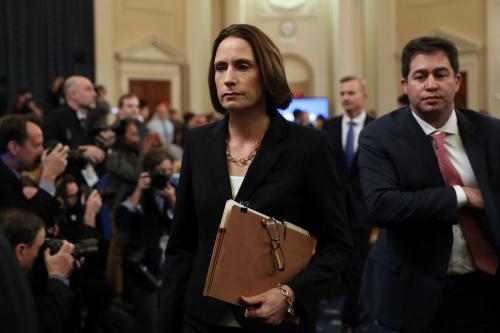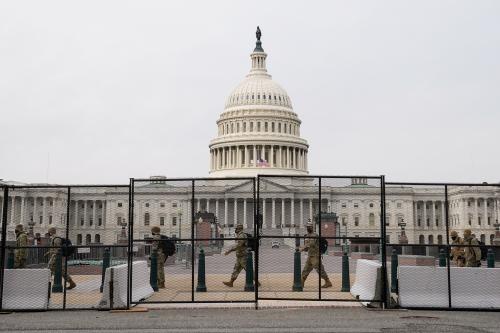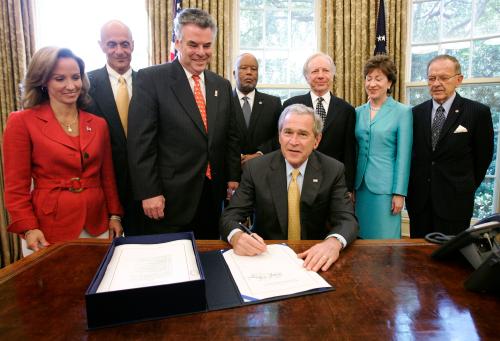One year ago, Brookings experts wrote a series of 12 memos to the incoming president on the most pressing policy issues facing the country. Now they assess the administration’s progress on those issues in The Status Report, a daily series of commentary with video to be featured in POLITICO’s Arena. Martin Indyk and Kenneth M. Pollack give the president an overall grade of B for confronting big challenges in a region that includes Iraq, Iran, terrorism in Yemen, and the Arab-Israeli conflict. That reflects an A for effort, they say, and a C for results that have so far not matched the promise of the administration’s ambitious agenda.
Facing Challenges in the Middle East: B
The Obama Administration faced a set of urgent, complex and intractable challenges in the Middle East. It sought to curb Iran’s nuclear program, reduce the American military role in Iraq while stabilizing the country, find a more effective way to deal with Middle Eastern sources of terrorism, resolve the Arab-Israeli conflict, and re-establish American leadership in a key region where the vast majority of the people saw Washington as the cause of their problems, not the solution. As we detailed in a memo to the president-elect last January, this was never going to be an easy task, nor one that could possibly be completed in the first year of a new administration. Certainly, the Obama Administration deserves credit for embracing these challenges and declaring a willingness to tackle them in ways very different from its predecessor. However, across the board, the results have yet to match the promise of its ambitious rhetoric. The president has arguably done best on Iran, where he did enact a new approach. On Iraq too, the administration is clearly marching in a different direction, but it is not yet clear that its approach will deliver the stability that American national interests demand. And the breakthrough to Arab-Israeli peace that was to be the engine of the administration’s strategy has yet to materialize, resulting in considerable disillusionment in the region.
On Iran, the Obama administration quickly adopted the best policy available, one of “carrots and sticks” in which the Islamic Republic would be offered engagement and real economic and political incentives to cease its pursuit of a nuclear weapons capability, or face harsh international sanctions if it refused. Unfortunately, no sooner had work begun to put this policy into practice than the disputed June 2009 Iranian presidential elections effectively obviated its entire premise because a much harder-line regime seized power in Tehran, one uninterested in better relations with the West and more concerned with internal challenges. Moreover, the Administration has been frustratingly meek in its support for the new Iranian opposition or in condemning the regime’s violent repression. This restraint has been driven by the increasingly chimerical hope that Tehran will seek meaningful compromise and engagement with the West but by avoiding real pressure on Iranian human rights violations in favor of engagement with a regime that appears to have little interest in it, the Obama Administration risks getting neither.
In Iraq, the Obama administration needed to drawdown American troops and continue to assist Iraq’s political transformation, while preventing a slide back into sectarian warfare, all too common in states that have undergone a major intercommunal civil war. Despite the occasional bombing outrage, overall levels of violence continue to fall and Obama succeeded in prodding the various Iraqi factions to enact an election law that provides for a reasonably good system of “open-list” elections. The President’s decision to drawdown the American military presence would see U.S. troops reduced to about 50,000 by August 2010. Although this plan still remains possible, it may be difficult to reconcile with Iraqi political needs. Iraqi elections now set for March seem likely to produce a fragmented parliament unable to form a government for months. If the United States is seen as blithely withdrawing its troops without regard for a deadlocked political situation or mounting violence, this could push the country back into civil war.
Achieving a breakthrough to comprehensive Arab-Israeli peace was meant to be the cornerstone of the new administration’s integrated Middle East strategy. The appointment of George Mitchell as the President’s envoy for Middle East peace on day two signaled the seriousness of that commitment. However, a deeply divided Palestinian polity with a weak leader, the delayed formation of an Israeli government with a right wing leader, and Arab state reluctance to play an overt facilitating role, gave Mitchell little to work with. Even restarting the negotiations on both the Palestinian and Syrian tracks eluded the administration.
New issues have also emerged in the region. The attempted Christmas terrorist attack by al-Qa’ida in the Arabian Peninsula (AQAP) finally brought the problem of Yemen into the American policy debate. Yemen (and potentially Somalia) represents a critical problem for the Obama Administration: how to prevent a failing state from becoming a new base for al-Qa’ida operations.
Like the delay in closing Guantanamo, it adds to the importance of achieving substantive progress on the administration’s other Middle East goals in its second year.
A longer version of this post is available here »
Javascript is not currently enabled in your browser.
Please enable Javascript in order to view this video.



Commentary
The Status Report: Obama’s Challenges in the Middle East
January 13, 2010